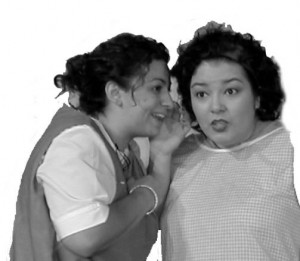El Corrido Del Barrio, A Story In Itself

Production #1, 1973 University of Colorado at Denver/ Touring Production
I was on my way to a Su Teatro rehearsal at the University of Colorado (then called the CUDC) theater located in the old Tramway building now called the Hotel Teatro. My path had cut me through the old Westside neighborhood in what is now the Auraria Campus. I walked down 9th Street where I had played touch football in the middle of the street. We would appropriate the street barriers, and continue to play as the confused drivers would be rerouted in order to allow us to continue our game. Eventually, a responsible adult would realize what we had done and make us unblock the street and return the barriers. All that was left of that life were a few boarded up houses. It was very sad.
I walked into the rehearsal and relayed what I had seen. I picked up my guitar, and sang, “Aqui vivimos en el barrio de West Denver” and so began the process of creating what has become one of the most important stories in Su Teatro’s history. We chose the style of the corrido (a ballad- a story put to music. It comes from the word correr which means to run.) Because we wanted the story to move. We wanted it to be mobile so we could take it anywhere. As college students who had caught the tail end of the radical anti-war movement and the Chicano Movement, we were inspired and motivated. We wanted to include these views that had shaped our lives, and we wanted to create a forum to comment on a variety of contemporary issues.

Yolanda Ortega and Debra Gallegos were part of the original cast and contributed to the ever evolving narrative. For the next year we traveled across the Southwest performing this story about community displacement and family, incorporating other political issues that struck our fancy at the time. By 1977, we had moved on to other stories and the play originally titled, “El Corrido de Auraria” was put aside.
Production #2, 1982 Slightly Off Center Theater/ Denver Center for the Performing Arts
We were moving into a period of new productivity. An opportunity arose at the Slightly Off Center Theater, which was then located on 15th Street, in Highlands. I was approached to direct a script; I thought in terms of the space that the corrido would be the best fit. I immediately got Debra and Yolanda aboard. Debra played Comadre Isabel, and Yolanda was the producer who had also committed to another production. Together we created the rewrites to complete the story. There was still the basic arc of the story with the neighborhoods of the Westside being represented by the character of Comadre Isabel. She, along with her next door neighbor Vecina Lina, were the mainstays of the story.
These two character names were drawn from memories of my childhood. Comadre Isabel was my favorite cousin of my mother’s and she had always been very close to our family. Vecina Lina was actually my Tia Lina, who was my father’s sister. My father was staying with her when she lived next door to my mother; henceforth, she would always be known as our neighbor. That is how my parents met and apparently how I came to be.
The success of the production was a surprise for us. I didn’t know why it should have been, but for some reason I never expected our audiences to react the way they did to seeing Su Teatro’s work presented at a regular theater. We had a sold out performance and positive critical responses, again, much to my surprise. Eventually we were invited to perform at the Denver Center for the Performing Arts by then Managing Director, Gully Stanford. It suddenly dawned on us that maybe there was a larger audience for our work. Su Teatro went on to present a successful weekend of El Corrido del Barrio.
Production #3, 1991, El Centro Su Teatro

Su Teatro had only recently established its first venue at the Elyria Elementary School, now renamed El Centro Su Teatro. This time Yolanda was to play the lead role of Comadre Isabel, with Debra playing the next door neighbor. Through a somewhat tragic twist of fate, there was a forced casting change in that year’s production. Yolanda was hit by a car while waiting for the bus on her way to work. She somehow contacted me from the ER and explained to me that she was sorry, but she had just been run over by a car and she didn’t think she would be able to perform that weekend. However, not to worry, she had spoken to Debra about subbing for her, if that was alright with me. Yolanda ended up having surgery and Debra completed her run.
Production #4, 1997 St. Cajetans Church
El Corrido del Barrio was produced as part of the St. Cajetan’s Reunification Project and presented in collaboration with Metropolitan State College- Denver, the University of Colorado at Denver and Su Teatro. Yolanda played the role of Comadre Isabel once again.
It was the first time the production was performed on the Auraria site, as the original production was developed in the time after the Westside was depopulated and the Auraria Campus was built. It was this time that the opening procession was introduced to the play. The procession was seen as a means of connecting the campus community with the neighborhood across Colfax Avenue.
The production took place in St. Cajetan’s Church, once the cultural, educational, financial and spiritual center of the Denver’s Mexican Community. Many former Aurarians attended; the emotional intensity was great. It was a great homecoming that would only become more profound.
Production #5, 2000 King Center
El Corrido del Barrio became the first production to take place in the newly built Eugenia Rawles Courtyard Theater at the King Center. The King Center was built on the site of the old St. Cajetan’s School. It is the school I went to from grades 1-8. It is the first stage I ever performed on. It is where so many of the stories and memories I have of the neighborhood come from.

Yolanda played the role of Comadre Isabel, although she had not been originally cast, she took over the role when Jamie Lujan had to leave the part because of an illness in the family. This is the reason Jamie is included in the publicity materials: she took the photos but was never in the play. This year we were able to add to our creative team with Carols Fresquez who designed the set and Daniel Lowenstein who painted it. Steve Nash designed the lights and under the Musical Direction of the talented Yamal Rima, the production made the jump from a guerilla theater production to actually being a fully realize stage production.
Production #6, 2011 Su Teatro at The Denver Civic Theatre
We decided to revive El Corrido del Barrio as a means of recognizing our past and celebrating our return to the Westside. We have been at the Denver Civic Theatre only about a year and a half and are still in the major process of transformation. We felt it was important to make that connection to complete our circle. It was only after we began production that we realized the production was 35 years old and the history that Yolanda and Debra have contributed to the production, as well as Su Teatro. Ironically, except for and because of Yolanda’s car accident, this will be the first time since 1976 that they are acting in the production at the same time. This is indeed something to celebrate. In all Yolanda has played Comradre Isabel 3 ½ times, and after this run Debra will have played the part 2 ½ times: neither of them originated in the roles. We all preferred more physical movement parts, so Yolanda and Debra played Muertos and I played Joey.
When we included the students from the Cultural Arts Education Institute (Ray Salas, Christina Madera, Kendall Thomas, Sombra Torrez and Stephen Garcia) all students at La Academia de la Gente and also Lindsey Young and Sofia Garcia in the production, it became a profound revelation that these young people were learning songs that were hundreds of years old. They were carrying on from the initial spark that I had experienced that day in 1975, as I walked down the rows of empty houses that had been my neighborhood. I had no idea that one day, a generation young enough to be our grandchildren, would be presenting the story of the Westside. There in lies the true legacy of those neighbors that lost their houses. We are those ghosts, manifested in artistic form.


